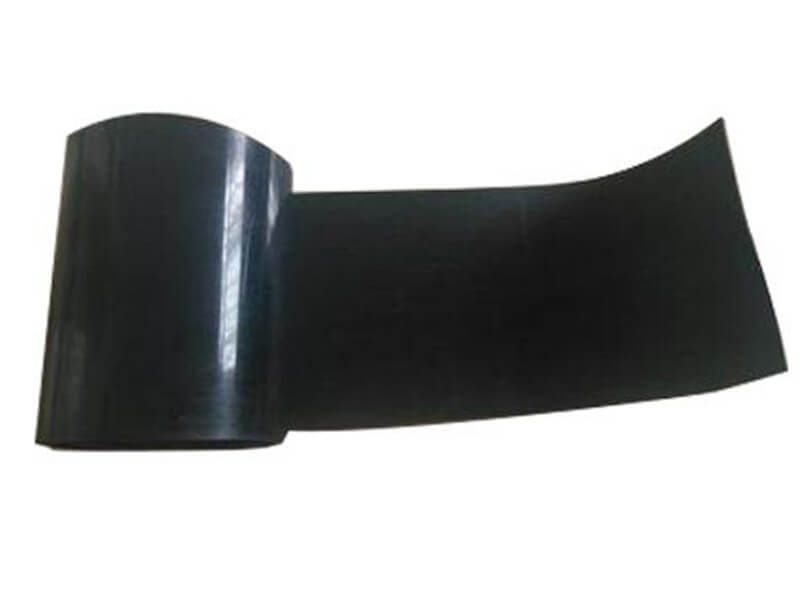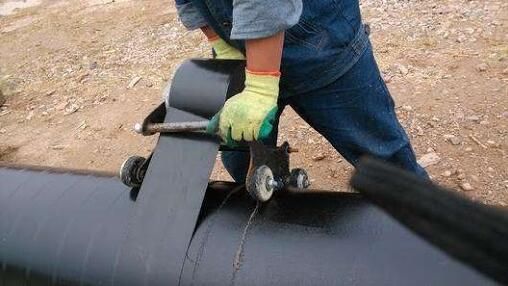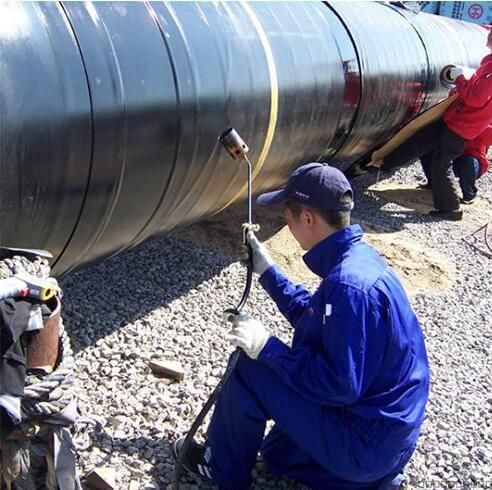In China, polyethylene heat shrinkable tape began to be used in the long-distance transportation of oil and gas pipe welded joints in the oil and natural gas industry in the late 1990s. At the beginning of this century, it has been widely used in the fields of long-distance oil transmission and natural gas pipe welding, urban gas pipeline joint, heating pipe, water pipe and so on.

Follow we describe the application of polyethylene shrink tape in steel pipe anti-corrosion from 5 aspects: the significance of steel pipe corrosion, the corrosion status of oil and gas pipes, brief introduction of heat shrinkable sleeve for anti-corrosion of oil and gas pipeline, the requirements of polyethylene shrink belt for anti-corrosion of oil and gas pipelines, and the application prospect of polyethylene shrink belt in oil and natural gas industry.
1. The significance of steel pipeline anti-corrosion
The corrosion of steel pipe exists in every department of national economy and national defense construction, which not only brings great loss to national economy, but also brings great difficulties to production and life. Steel pipes are corroded all the time under natural conditions (atmosphere, natural water, soil) or artificial conditions (acid, alkali, salt and other media). It is a spontaneous and unnecessary consumption. The fundamental reason is that the steel pipeline is in the thermodynamic unstable state. Under the above conditions, they will return to the original relatively stable state and form iron oxide Carbonate, etc. or converted to soluble ions. This process is the corrosion process of metal. According to statistics, China's annual output of iron and steel is 160 million tons. More than 60 million tons are lost due to corrosion every year. Corrosion is not only a waste of iron and steel resources, but also shortens the service life of pipelines and equipment due to corrosion. The cost of replacing new pipelines and equipment is far more than the price of metal materials. Therefore, the production cost increases and the economic benefits are reduced. The direct and indirect economic losses caused by corrosion are huge. Corrosion products form scale layer, which affects heat transfer and medium flow rate. Heat transfer efficiency is reduced and energy consumption is greatly increased. The economic loss caused by corrosion in China is as high as 280 billion yuan every year, which is more than the sum of natural disasters such as wind, flood, earthquake and fire.
Corrosion causes various accidents and major disasters. Due to the corrosion of steel pipes and equipment, the production enterprises shut down and the quality of products decreased. It affects the living supply, gas supply, heating steam or hot water, and brings a lot of difficulties to people's life. The leakage of buried oil, gas, water and other pipelines and pipe networks, the leakage of oil refining, chemical, chemical fiber, chemical fertilizer, pharmaceutical and other pipelines and equipment in enterprises, not only causes the loss of a large number of useful substances, but also causes serious environmental pollution, and even causes catastrophic accidents such as fire, explosion and collapse. In view of the widespread existence of metal corrosion, in order to prevent or slow down the occurrence of metal corrosion, various metal anti-corrosion technologies and processes came into being. The popularization and application of new metal anti-corrosion technology, new materials and new equipment can extend the service life of pipeline equipment, save money and ensure safe production. In China's petrochemical industry, public utilities and other industries, the pipeline is perforated for 20000 times per year due to corrosion, which mainly occurs in the joint of steel pipe and the pipeline itself.

2.Corrosion status of oil and gas pipeline
According to the investigation and statistics, the damage caused by corrosion accounts for about 30% of the pipeline accidents in China. In several oil fields in the east of China, the number of corrosion perforation of various pipelines reaches 20000 times / year, and the number of replacement pipelines is 400km / year. During the 15 years from May 1971 to May 1986, there were 83 explosion and combustion accidents caused by corrosion in Sichuan natural gas pipeline, with an economic loss of more than 600 million yuan. In 1993, the economic loss caused by corrosion in Zhongyuan Oilfield was 1.6 billion yuan. The economic loss caused by corrosion in China's petrochemical industry in 1989 was about 2 billion yuan.
Corrosion principle and influencing factors of oil and gas pipeline
Long distance oil and gas pipelines are hundreds of kilometers in length and thousands of kilometers in length. Due to the heterogeneous soil, freezing and thawing in winter and summer, the change of underground water level, the penetration of microbial stray current by plant roots to coatings and other complex buried conditions, the pipelines pass through different types of soil rivers and lakes, resulting in complex corrosion rings, such as organic sulfide, salt, formation water, etc Mineral oxygen. Most of the corrosion encountered in the production of oil and gas fields and urban gas pipeline network in China is electrochemical corrosion. The principle of soil corrosion belongs to electrochemical corrosion. The main influencing factors of soil corrosion are soil resistivity, soil oxidation potential, salt content, water and air content, soil temperature, acidity, microorganism and stray current
Anti-corrosion technology of oil and gas pipeline
The Anti-corrosion forms of buried oil and gas pipelines usually include internal Anti-corrosion, external Anti-corrosion, cathodic protection and above ground Anti-corrosion. Requirements for external anti-corrosion coating of buried pipeline: good anti-corrosion and construction performance of soil, water and mold, good electrical insulation. When used in combination with cathodic protection, the anti-corrosion coating shall have certain ability to resist cathodic stripping strength and sufficient mechanical strength, so as to ensure that the coating will not be damaged under the action of transportation and soil pressure. Buried steel pipe external Anti-corrosion coating technology includes asphalt asphalt anti-corrosive coating, epoxy coal tar anti-corrosive coating, coal tar enamel anti-corrosive coating, polyethylene adhesive tape, fused epoxy powder anti-corrosive coating, two layer PE anti-corrosive coating, three PE anti-corrosive coating and polyurethane rigid foam plastic anti-corrosive and thermal insulation composite structure. The latter three methods are commonly used.
3.Brief introduction of polyethylene heat shrinkable tape for anti-corrosion of oil and gas pipeline
Polyethylene heat shrinkable tape is a new type of anti-corrosive material for steel pipe weld with good performance and easy operation. It is composed of base material and hot-melt adhesive layer. The base material is the plastic sleeve (sheet) formed by extrusion, radiation crosslinking and stretching of polyethylene. Hot melt adhesive is a kind of special adhesive. It is solid at room temperature. It can flow when heated and can be coated on the substrate. It has good adhesion to metal and plastic. The external anti-corrosion coating of steel pipe is usually three-layer structure (also known as three-layer PE anti-corrosion). The one contacting with steel pipe is anti-corrosion paint primer. The middle is hot melt adhesive. The outermost layer is cross-linked polyethylene. In a few cases, the external anti-corrosion coating of steel pipe is two-layer (two-layer PE anti-corrosion), the sealing hot-melt adhesive is in contact with the steel pipe, and the outer layer is cross-linked polyethylene. The antisepsis of jacket is made up of foam jacket (inner layer) hot melt adhesive (middle layer) and base material (outer layer). For technical requirements, see oil and gas industry standard SY/T0413 - 2002 "buried steel pipeline polyethylene anti-corrosion coating technical standard" SY/T4054 - 2003 radiation crosslinked polyethylene polyethylene heat shrinkable tape (set) ", SY/T0415 1996" buried steel pipeline rigid polyurethane foam plastic anti-corrosive insulation layer technical standard ".

4.Requirements of polyethylene heat shrinkable tape for anti-corrosion of oil and gas pipeline
General requirements for steel pipe patching construction
Before patching, the patching part must be cleaned. The burr, welding slag, dirt, oil and other sundries near the circumferential weld must be cleaned. Derusting treatment shall be carried out on the surface of patching part, and the quality of surface derusting treatment shall reach sa2.5-sa3.0 specified in "rust grade and derusting grade of steel surface before painting" GB / 8923. Sand blasting or electric tools can be used to remove rust. The polyethylene layer at the lap joint shall be ground to rough surface. Groove treatment shall be carried out at the end and groove treatment shall be carried out at the end of the slope angle. The slope angle shall not be greater than 30 degrees. Then, the flame heater shall be used to preheat the patching part. The lap width between anticorrosive polyethylene heat shrinkable tape and polyethylene anticorrosive coating shall not be less than 100 mm. If the humidity is more than 85% or in rainy or snowy days, the construction shall be stopped.
Quality inspection after construction
The quality inspection of anti-corrosion polyethylene heat shrinkable tape or winding tape shall check the appearance of patching one by one. The surface of anti-corrosion polyethylene heat shrinkable tape or winding tape shall be smooth and flat without wrinkles and bubbles. The slope corners at both ends shall be closely connected with the heat shrinkable sleeve without voids. There shall be no carbonization on the surface. There should be hot melt adhesive overflowing evenly around the PE heat shrinkable tape. A spark leak detector is used to inspect the pinholes one by one at the joint patching. The leak detection voltage is 15kV. In case of pinhole, it should be re patched. The adhesive force of anti-corrosion polyethylene heat shrinkable tape shall meet the requirements. The peel strength of anti-corrosion polyethylene heat shrinkable tape shall not be less than 50N / cm when the temperature of pipe body is about 25 ℃
Quality inspection of anti-corrosive coating (primer) The quality of anti-corrosion coating (primer) is mainly leak detection. When the coating is fully cured and cooled to the ambient temperature, each patch is detected. The test voltage is 2KV for ordinary level and 2.5KV for reinforced level. When the test head contacts the coating, it moves at a speed of about 0.2m/s.
5.Application prospect of polyethylene heat shrinkable tape in anti-corrosion of oil and gas pipeline
With the rapid development of national economy, China's demand for energy is growing. There are more and more long-distance oil transportation, gas pipeline engineering and urban gas pipeline network construction. During the Tenth Five Year Plan period, the long-distance oil and gas pipeline projects will exceed 20000 km. The urban gas pipeline network projects will be nearly 30000 km. The demand for polyethylene heat shrinkable tape is more than 3 billion yuan, and there are few qualified domestic manufacturers. The application prospect of polyethylene heat shrinkable tape in anti-corrosion of buried oil pipeline is very broad.